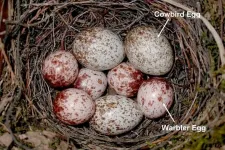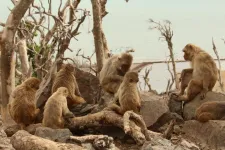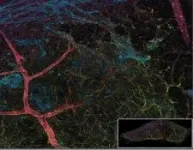(Press-News.org) CHAMPAIGN, Ill. -- Avian brood parasites lay their eggs in the nests of other bird species, forcing the hosts to do the hard work of raising the unrelated young. A team of scientists wanted to simulate the task of piercing an egg - a tactic that only a minority of host birds use to help grasp and eject the foreign eggs. Their study offers insight into some of the physical challenges the discriminating host birds face.
The new findings appear in the Journal of Experimental Biology.
Take cowbirds, for example. Their eggs look nothing like the host birds' eggs, "yet most of their hosts do not reject the parasite eggs," said study co-author Mark Hauber, a professor of evolution, ecology and behavior at the U. of I. and a brood parasitism expert. "One explanation is that the cowbird eggshell is too thick and strong for a small host's beak to pierce."
To determine whether the difficulty of piercing a brood parasite's egg played a role in whether the host bird tried to eject it, Daniel Clark, an undergraduate student working in Hauber's laboratory, teamed up with another professor in the same department, Philip Anderson, an expert in the biomechanics of piercing, slashing and stabbing. Anderson has previously studied the characteristics that contribute to the cutting and crushing ability of teeth and the piercing power of viper fangs and cactus spines.
The team used chicken eggs in the experiments because collecting and destroying wild bird eggs would be ethically problematic and difficult to standardize. The researchers wanted to determine which elements influenced an egg's ability to withstand being pierced.
"The factors we specifically looked at in the paper were the presence of a nest, the sharpness of the bird's beak and the speed at which it struck the egg," Clark said.
The team measured the energy required to pierce the eggs under different conditions: with and without a nest supporting the egg, with a piercing object approaching the eggs at high or low speeds, and with dull or sharp objects. The researchers used the sharp end of a nail to simulate a sharp beak, and the nail head as a proxy for a dull beak. The experiments involved either a fast-swinging pendulum-mounted nail or a materials-testing device that slowly pushed the nail into the egg.
The researchers said they were surprised to find that the dull end of the nail did a better job of piercing the egg than the sharp end, particularly when striking the egg at a higher speed.
"My lab has done a lot of research on puncture and cutting mechanics, but we've always been looking at soft materials such as skin or muscle," Anderson said. "An eggshell is brittle - more like ceramic than skin. If you're trying to break something brittle, like glass, it makes more sense to use a hammer than a knife, so this result is not as surprising at it seemed at first."
The experiments also revealed that nests absorb some of the energy of the nail strike, particularly when the nail moves at slower speeds.
"In the slow-moving experiment, the nest mattered a lot, but the sharpness or dullness of the nail mattered less," Clark said. "In the fast-moving experiment, the nest mattered less but the sharpness of the nail ended up mattering a lot."
The team also discovered that the act of repeatedly striking eggs dulled even the sharp end of a steel nail.
"This shows that biological surfaces are a lot more tough and durable than we think," Clark said.
If pecking at a foreign egg rapidly in the bottom of a nest damages its beak, the host bird might reduce its ability to preen, weave its own nest or feed itself and its young. These findings offer clues to the factors that influence how - and whether - a host bird responds to the arrival of a foreign egg in its nest, the researchers said.
"Our experiments help us to understand the long-standing conundrum of why most hosts of the cowbird and its conspicuous egg have not evolved to eject the parasitic egg from the nest," Hauber said.
INFORMATION:
The National Science Foundation and the Joseph B. Hawkes Research Award from the U. of I. supported this research.
Editor's notes:
To reach Daniel Clark, email dlclark2021@gmail.com.
To reach Philip Anderson, email andersps@illinois.edu.
To reach Mark Hauber, email mhauber@illinois.edu.
The paper "Nest substrate and tool shape significantly affect the mechanics and energy requirements of avian eggshell puncture," is available online and from the U. of I. News Bureau.
Natural disasters have a way of bringing people together to rebuild. Now, researchers reporting in the journal Current Biology on April 8 have found that the same is true for rhesus macaques.
The study reports that after a major hurricane hit Puerto Rico, macaques living on Cayo Santiago Island became more tolerant of each other and sought new social connections. The findings are based on careful study of social connections among Cayo Santiago Island's macaques before and after Hurricane Maria, a devastating storm that left more than 3,000 people dead.
"The macaques ...
Chest beating by mountain gorillas - rapidly beating their chests with their hands to produce a drumming sound - may convey information about their body size and allow identification of individuals, a study published in Scientific Reports suggests. These findings demonstrate how non-vocal behaviours may contribute to mountain gorilla communication.
Although it had previously been suggested that gorillas may beat their chests to convey information, the exact nature of that information was unclear. Edward Wright and colleagues observed and recorded 25 wild, adult male silverback gorillas monitored by the Dian Fossey Gorilla Fund in Volcanoes National Park, Rwanda, between January 2014 and July 2016. Body size was determined from photographs ...
Along the Tian Shan and Alay mountain ranges of Central Asia, sheep and other domestic livestock form the core economy of contemporary life. Although it was here that the movements of their ancient predecessors helped to shape the great trade networks of the Silk Road, domestic animals were thought to have come relatively late to the region. A new study, published today in the journal Nature: Human Behavior, reveals that the roots of animal domestication in Central Asia stretch back at least 8,000 years - making the region one of the oldest continuously inhabited pastoral landscapes in the world.
The domestication ...
Ageing and age-related brain disease do not affect women and men in the same way. The adult brain constantly generates new brain cells called neurons from stem cells, a process called neurogenesis. This process is important for learning and cognitive function which declines as the brain ages. Neurogenesis has been extensively studied in animals, but most studies have looked at male animals, raising the question of whether age-related decline in neurogenesis affects both sexes in the same way. To address this, researchers Sally Temple, PhD (sallytemple@neuralsci.org), Kristen Zuloga, PhD (zuloagk@amc.edu) and colleagues at the NY Neural Stem ...
Mutations in the DNA of the cell's energy 'factories' increases the chances of survival for people with bowel cancer, according to a study published today (Thursday) in Nature Metabolism.
Scientists funded by Cancer Research UK have found that patients with colorectal cancer, a common form of bowel cancer, had a 57 to 93% decreased risk of death from their cancer, depending on the presence and type of mitochondrial DNA mutations in their tumours.
The researchers hope that in the future, doctors could use this information to identify patients with more aggressive forms of bowel ...
What The Study Did: This analysis evaluated in-hospital mortality rates for patients with SARS-CoV-2 infection over time and factors associated with changes were examined
Authors: Lyn Finelli, Dr.P.H., M.S., of Merck Research Labs in North Wales, Pennsylvania, is the corresponding author.
To access the embargoed study: Visit our For The Media website at this link https://media.jamanetwork.com/
(doi:10.1001/jamanetworkopen.2021.6556)
Editor's Note: The article includes conflict of interest and funding/support disclosures. Please see the article for additional information, including other authors, author contributions ...
Gorillas usually stand bipedally and rapidly beat their chests with cupped hands in rapid succession. Chest beating is a unique sound because is it not a vocalization, like frogs croaking, but rather it is a form of gestural communication that can be both heard and seen. The emanating drumming sound can be heard over one kilometre away. The presumed function of gorilla chest beats is to attract females and intimidate rival males.
Researchers recorded chest beats and used a technique called photogrammetry to non-invasively measured body size of adult male wild mountain gorillas monitored by the Dian Fossey Gorilla Fund in Volcanoes National Park, Rwanda. They found that larger males emitted chest beats with lower peak frequencies than smaller ones. In other words, ...
The U.S. military veteran population is known to have abnormally high rates of suicide, so health officials have been concerned that the COVID-19 pandemic might elevate risk of psychiatric disorders, particularly among those suffering from post-traumatic stress and related disorders.
A recent national study of more than 3,000 veterans participating in the National Health and Resilience in Veterans Study did find that 12.8% reported post-traumatic stress disorder (PTSD) symptoms related to COVID-19 and 8% said they had contemplated suicide during the pandemic.
However, the same survey, published April 8 in JAMA Network Open, revealed another, startling finding. A full 43.3% ...
What The Study Did: This survey study uses self-reported data from a national study of veterans to assess the association of symptoms of posttraumatic stress disorder with posttraumatic psychological growth (these are positive psychological changes such as an appreciation of life and personal growth) among U.S. veterans during the COVID-19 pandemic.
Authors: Robert H. Pietrzak, Ph.D., M.P.H., of the U.S. Department of Veterans Affairs National Center for Posttraumatic Stress Disorder and the VA Connecticut Healthcare System in West Haven, is the corresponding author.
To access the embargoed study: Visit our For The Media website at this link https://media.jamanetwork.com/
(doi:10.1001/jamanetworkopen.2021.4972)
Editor's ...
It may be possible in the future to use information technology where electron spin is used to store, process and transfer information in quantum computers. It has long been the goal of scientists to be able to use spin-based quantum information technology at room temperature. A team of researchers from Sweden, Finland and Japan have now constructed a semiconductor component in which information can be efficiently exchanged between electron spin and light at room temperature and above. The new method is described in an article published in Nature Photonics. ...




